
Best Light + Medium Hold Gels That Actually Work in Dry Climates (Fall & Winter)
Light and medium-hold gels are one of the biggest categories out there — and honestly, most of them don’t work. I’ve tested hundreds of gels.
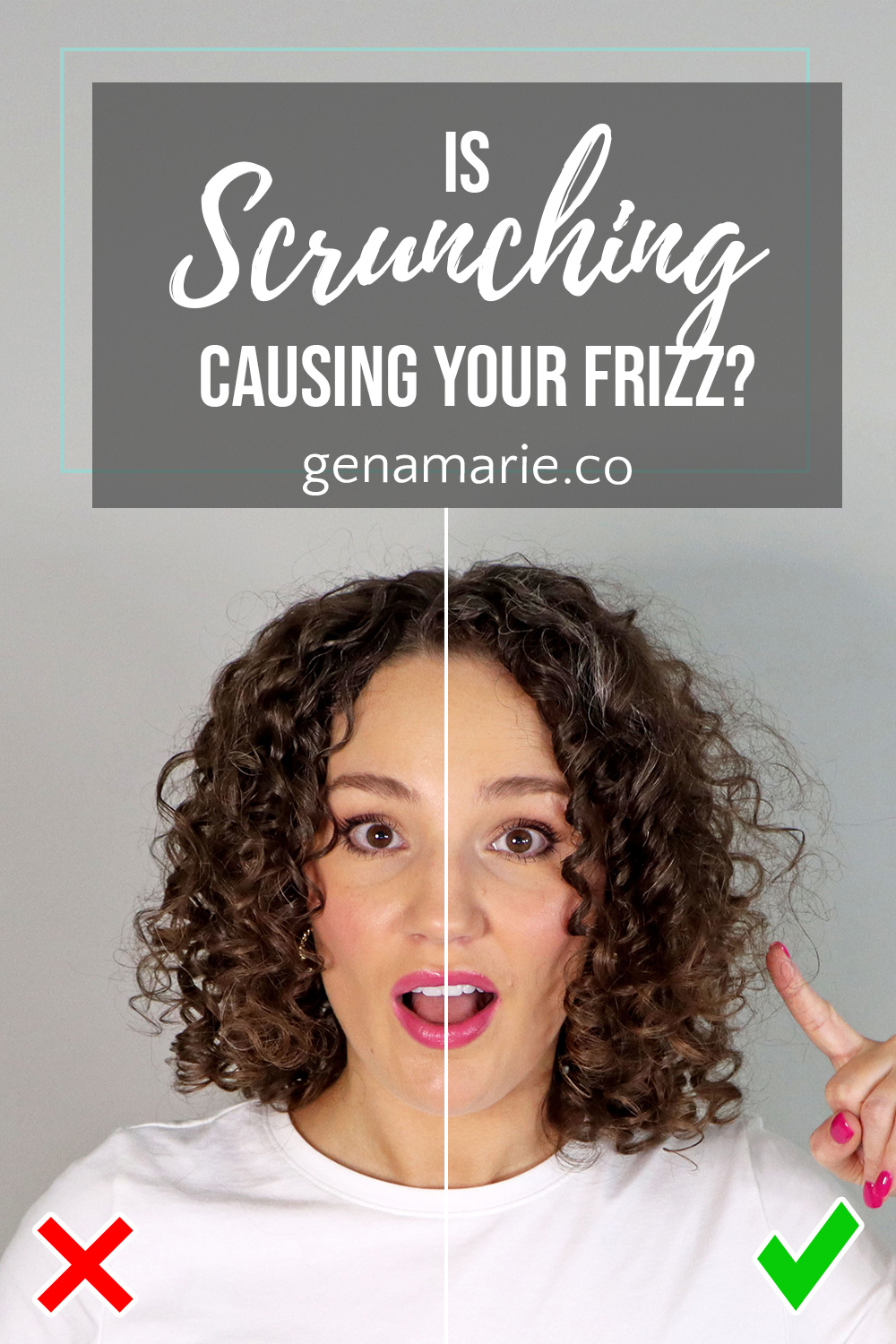
Is scrunching the reason your waves and curls are frizzy? Today I did a side-by-side split test where I styled both sides of my hair with the exact same products and routine – but on one side I scrunched using common techniques I see people using, and on the other side I didn’t scrunch at all.
Can you tell which is which? And don’t worry, I am also sharing some alternatives which may help you achieve curl definition without causing frizz.
Through my curl coaching, I help my clients identify when common curly hair methods, such as scrunching, may not be the best fit for their unique hair type. Scrunching is one of those things that becomes second nature – but it might actually be working against you, especially if you have frizz-prone areas, new growth, or high porosity sections like I do.
First, I started with clean, damp hair. Before styling, I took my hair down from my Hair RePear towel and misted my hair with water to ensure it remained evenly wet. Keeping your hair wet while styling is important when trying to manage wet frizz.
I then applied the Living Proof Leave-In Conditioning spray as a heat protectant and to prep my hair. I like to do this by spraying it on my hands and then brushing it through to make sure it’s evenly distributed.
Then, I sectioned my hair and applied gel by raking it in. Today I went with one of my favorite gels, the Jessicurl Spiralicious Gel. I know when I do my best application techniques, my frizz is controlled, so I really want to see the difference scrunching makes.
This gel provides a buildable hold, but I can get a strong hold out of it with my Strong Hold Method which you can download for free by clicking the link.
I also used the praying hands method to smooth frizz and clump the curls. When applying your gel, you want to focus on evenly coating all strands and smoothing the hair downwards.
This is where a lot of people start scrunching too early — and one of the most common mistakes I see in my guided styling coaching calls. If you’re applying product by grabbing at random sections or rubbing your hair between your fingers, I call this the “crab hands” method. This motion breaks up clumps and creates frizz before your curls even start to form.
Always smooth first. Lay the foundation before you activate the curl pattern.
Next, I styled as I normally would. On both sides, I brush styled for even distribution and definition. On my top section, I finger coiled the front pieces for root lift.
I often scrunch each section as I go, but today I fully styled my hair and scrunched at the end to be able to fully show you the differences.
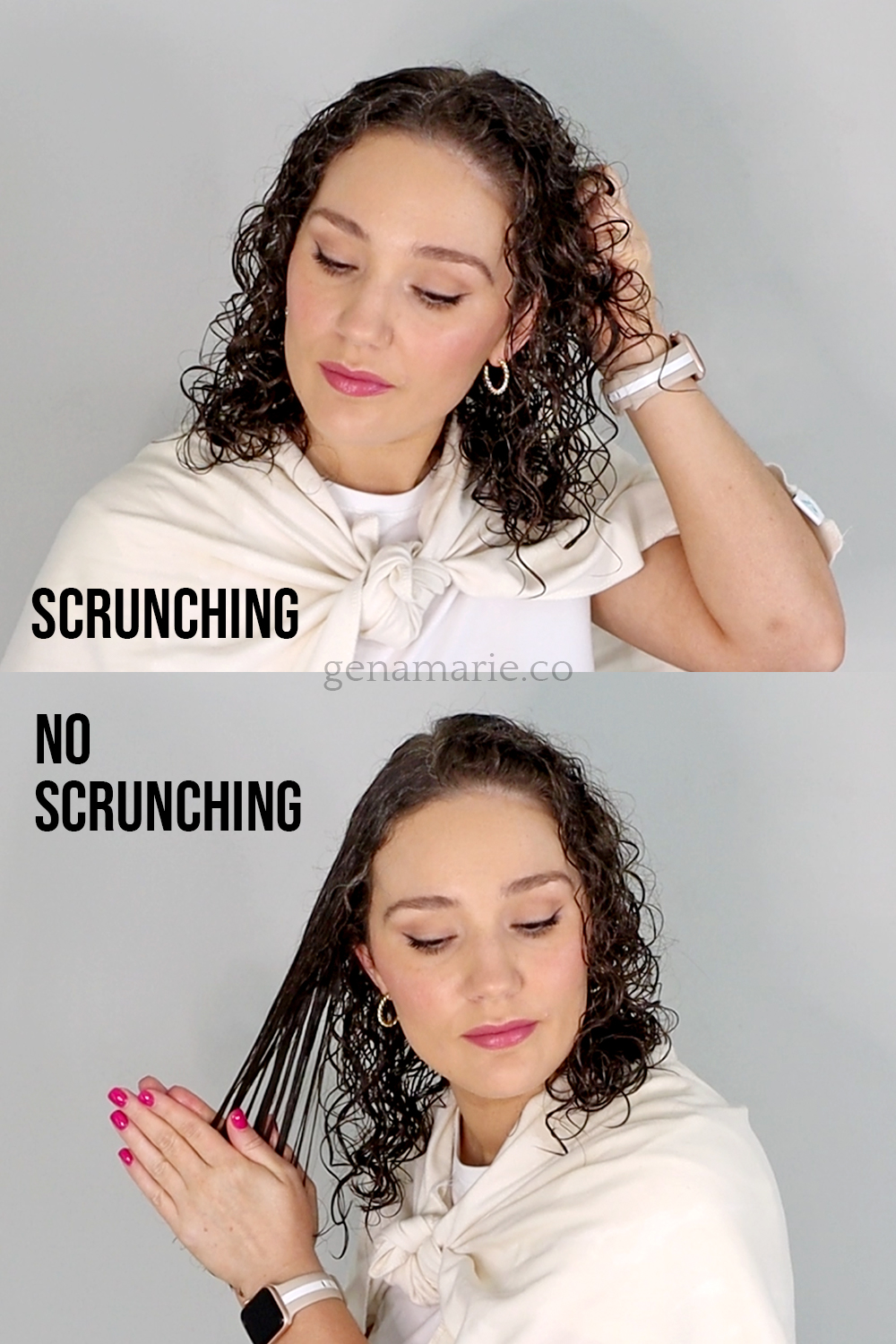
For today’s test, I only scrunched on one side.
On the right side, I scrunched the way I often see people do it – quickly, lifting everything up without thinking much about how the curls land. I was intentionally a little messy here, because this is exactly what I see causing frizz for a lot of people – especially near the root or in areas with short, porous, or damaged hair.
On the left side, I skipped scrunching entirely. I just let the brush styling and finger coils do the work, and allowed the clumps to set on their own.
After styling, I microplopped with a towel to remove excess water and set the clumps. But here’s another sneaky moment where scrunching can cause frizz – especially when the hair is half-dry and more fragile.
On the right side, I scrunched haphazardly with the towel, which causes frizz to form. Then, I added some extra gel by scrunching again. Since my hands were sticky with gel and my hair was starting to dry, this caused my hair to stick to my hands and frizz to pop out.
On the left side, I squeezed out excess water gently with my towel from the side. I did not scrunch from the ends up like usual. After, I smoothed/glazed a bit of extra gel over the surface. I did not scrunch and was careful not to disturb the curls.
When diffusing, and I did the same routine, same settings, and same technique on both sides.
Now, I did scrunch a bit while diffusing. But there is a right and wrong way to scrunch diffuse if you tend to get frizz.
On the right side, I scrunched rapidly with the diffuser pointed straight up, which causes frizz. I also used my hand to scrunch my hair while I was diffusing, which is a common mistake and a major cause of frizz.
On the left side, I did not scrunch rapidly with my diffuser. Instead, I moved slowly, section by section and I paid close attention to how the hair was positioned in the bowl. I always point the diffuser perpendicular to my head instead of pointing it straight up.
When I scrunch while diffusing, I use the same gentle approach – no jabbing, no messy lifting. If you need more help with your diffusing techniques, check out my recent video about common diffusing mistakes and how to fix them!
Even at this step, how you scrunch matters too!
On the right side, I scrunched aggressively, grabbing at the hair when breaking the cast, which causes frizz. Scrunching while your hair is still wet or if your hands are sticky will also cause frizz.
On the left side, I still used my whole hand to scrunch from the ends up to the roots, and avoided yanking at the mid-shaft or roots. I focused on the mid-lengths and ends first, then gently fluffed the root area with my fingertips – avoid digging in or shaking it out aggressively. Keeping your hands underneath your hair can really help reduce frizz.
If you have waves or loose curls that struggle to bounce up, you might be wondering: “How can I encourage my curl pattern without causing frizz?” Scrunching itself isn’t always bad — but most of the time when I see frizz happening, it’s because of how someone is scrunching. Here are some of the biggest mistakes I see — and what to do instead:
❌ Mistake 1: Scrunching too early — before the product is fully smoothed in.
✅ Fix: Always apply your gel first by raking to smooth the hair, then use praying hands for some light tension and clumping before scrunching.
❌ Mistake 2: Using “crab hands” — grabbing sections or pinching at the hair with your fingertips.
✅ Fix: Use your full palm to gently lift and support the curls from the ends. To get volume, reach underneath and gently lift the roots, then scrunch.
❌ Mistake 3: Scrunching too close to the root or mid-shaft — especially in frizz-prone areas.
✅ Fix: Focus on the mid-lengths and ends, and avoid scrunching near the root, especially if that’s where you get frizz. You can also use your other hand to pinch the hair at the root away from the scalp and then scrunch.
❌ Mistake 4: Rushing or pulsing too aggressively.
✅ Fix: Pulse slowly and allow the curl to land naturally in your hand.
Watch the video to see these in action.
If you have breakage, short new hairs, or high porosity sections, those areas often do better with just smoothing — not scrunching. So instead of scrunching everything by default, try scrunching only where you need it — like at the ends or outer layers — and skip the parts that always frizz up.
These can help activate curl formation without introducing friction. I did not use them in today’s test, but they’re worth trying if you’re looking to avoid scrunching entirely. For this test, I scrunched one side like most people do, and skipped it completely on the other — so we can really see the difference. But if you’re scrunching like this and still seeing frizz, this might be why.
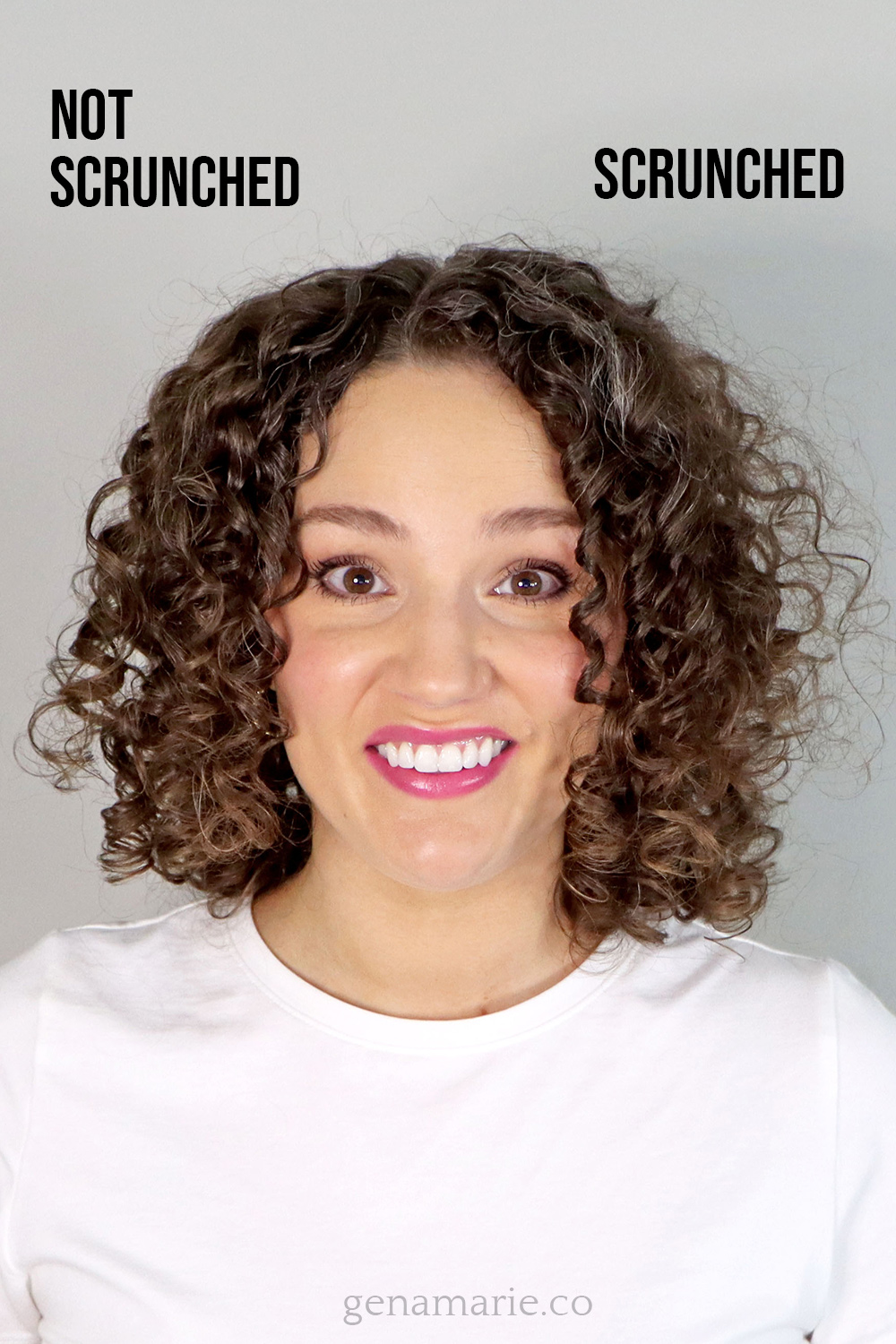
There was a major difference between each side! The side that I scrunched improperly has a lot of frizz and is lacking definition, whereas the side I didn’t scrunch does not have much frizz. The hair is never going to be completely frizz-free, so some frizz is normal.
On the side that I didn’t scrunch, I was still able to get definition, clumps, and volume because of my styling techniques and diffusing. The tightness of your curls and your volume have more to do with your natural curl pattern and how you diffuse. Diffusing is where most of the curl formation happens anyway! My hair may be elongated when it’s wet after styling, but diffusing shrinks it up to its natural curl pattern.
So… is scrunching bad? Not necessarily. But here’s the truth:
My biggest takeaway from this is the importance of paying attention while you’re styling and diffusing. When you pay attention and are mindful of the hair placement at each step, you’ll really see how it makes a difference.
If you’ve ever felt like you’re doing everything right but still end up with frizz, scrunching might be the missing part of the puzzle. If you’ve tried all of these scrunching alternatives and are still struggling with frizz, there may be another root cause that I would love to help you get to the bottom of.
In my group curl coaching membership, I will audit your routine, help guide you in real-time through styling and diffusing, and troubleshoot all these little details that make a big difference. Enrollment officially re-opens Sept. 1, but if you want in early for a discount, send me an email or DM and let’s chat!


Light and medium-hold gels are one of the biggest categories out there — and honestly, most of them don’t work. I’ve tested hundreds of gels.
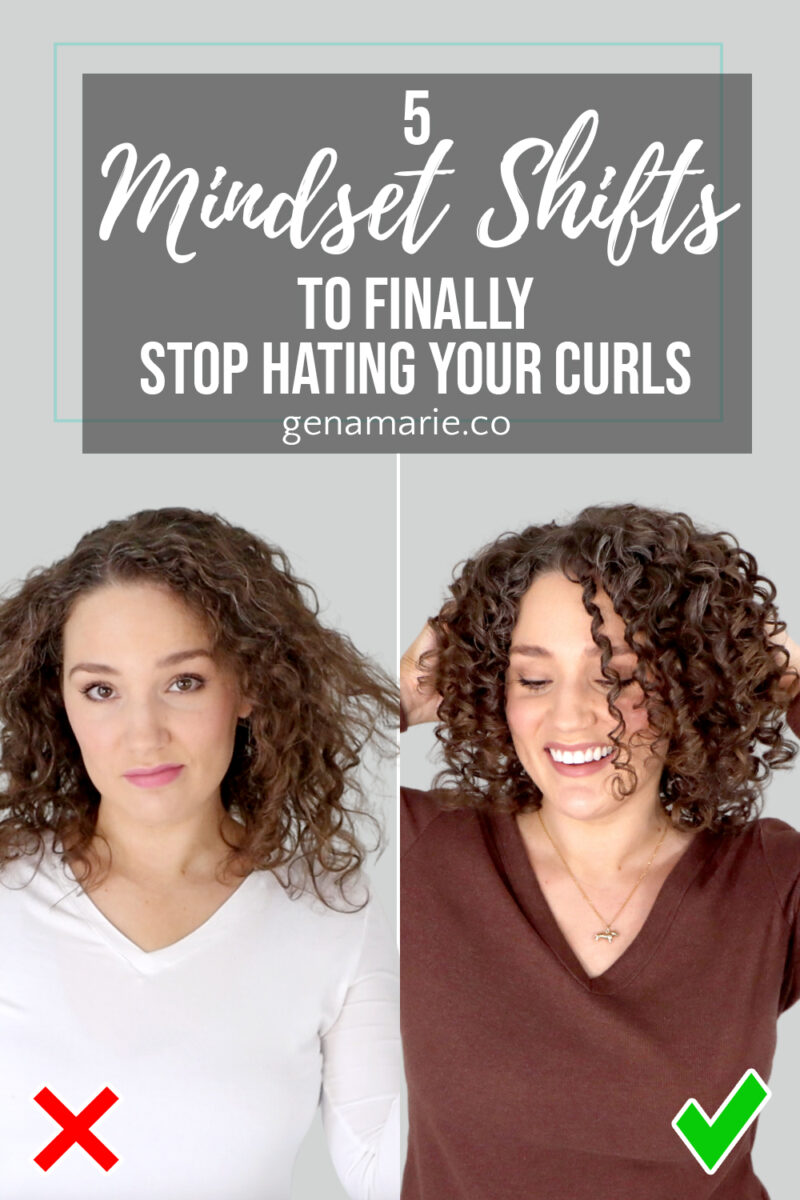
If you’ve ever felt frustrated with your hair or caught yourself thinking, “I just have bad hair,” “Nothing ever works for me,” or “My curls
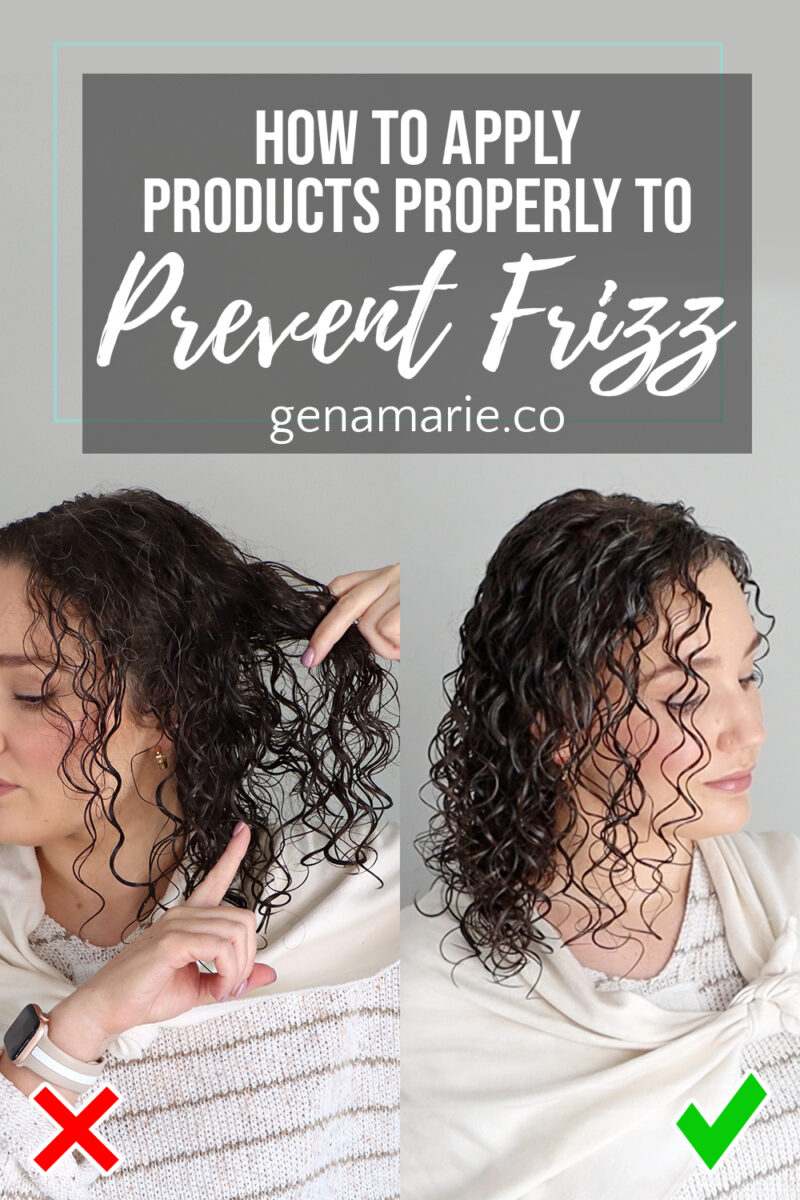
If you’re still getting frizz even though you’ve tried so many products, the issue may not be the products at all — it might be

I’ve rounded up some of my top curly hair and beauty favorites that are on sale for Black Friday and Cyber Monday. I’ve included quick
Notifications